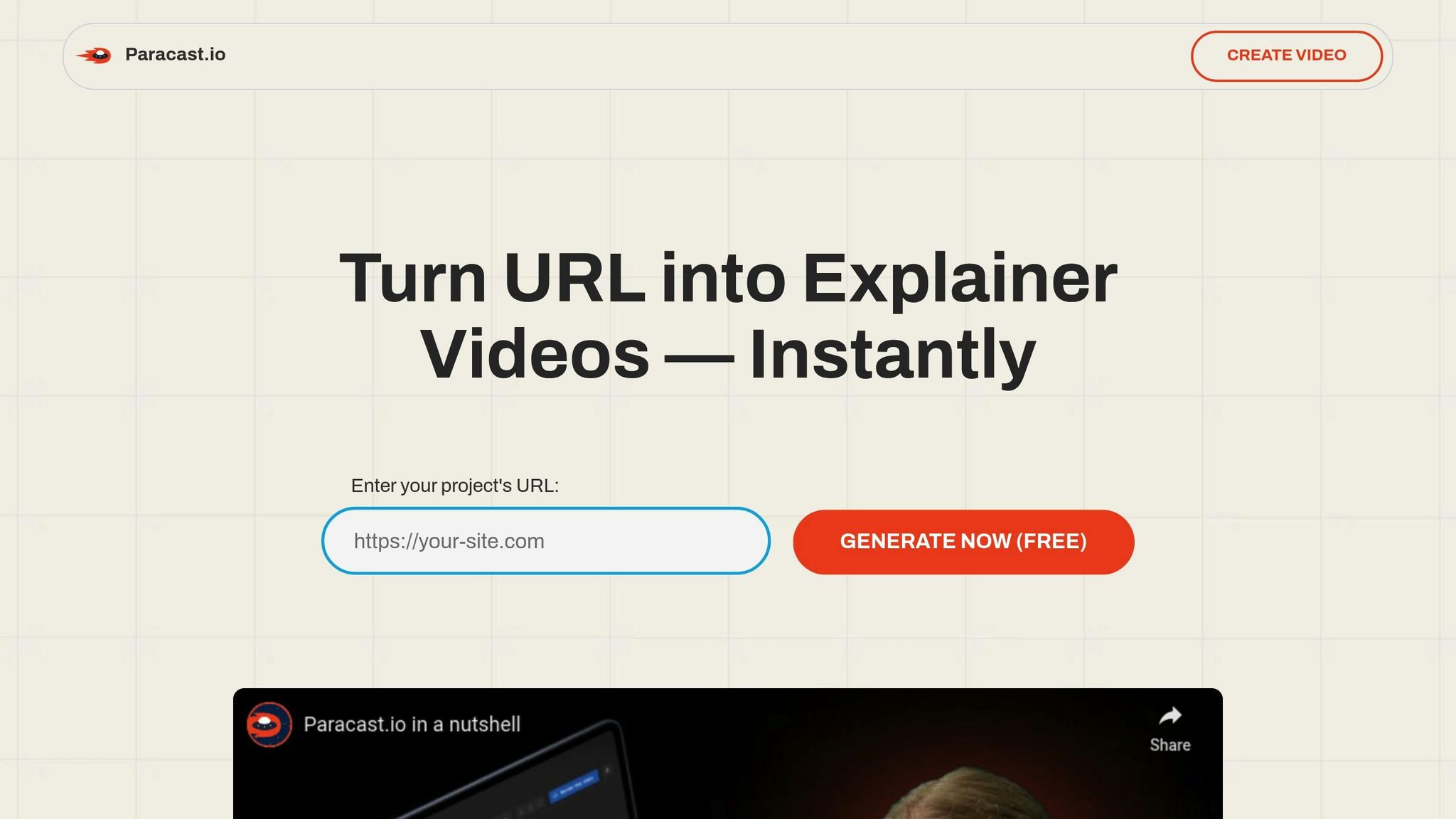When creating videos for your startup, getting the length right is critical. Too short, and you might miss delivering your message. Too long, and viewers lose interest. Here's what you need to know:
- Platform matters: Each platform has its ideal video length. For example, TikTok thrives on 15–60 seconds, while YouTube supports longer, detailed videos (2–3 minutes or more).
- Content type matters: Quick product demos work well in under 30 seconds, while explainer videos or testimonials may need 1–2 minutes.
- Engagement affects visibility: Algorithms reward videos that keep viewers watching. Completion rates are key - shorter videos often see higher rates, but longer videos can drive deeper engagement.
- Test and analyze: Use A/B testing to find the best length for your audience. Track metrics like watch time and drop-off rates to refine your approach.
For startups, every second counts. Tailor your video length to your audience, platform, and message for maximum impact. Tools like Paracast.io can simplify video creation, letting you focus on strategy while ensuring your content fits platform preferences.
Maximize Engagement on EVERY Social Media Platform | The Ultimate Guide to Video Length
Why Video Length Matters for Startup Marketing
The length of your video can make or break your startup's ability to stand out. In today’s noisy digital world, the right video length can help grab attention and turn casual viewers into loyal customers. For startups, this is especially crucial when competing against well-established brands with huge marketing budgets.
Every second counts, and startups don’t have the luxury of wasting resources on videos that don’t deliver results. This guide dives into how tailoring video lengths can help startups overcome these challenges.
How Video Length Affects Engagement and Retention
Viewer attention spans depend on their goals and where they’re watching. The trick is to align your video’s length with both the viewer’s mindset and the purpose of your content.
Short videos are perfect for quick, impactful messages or visually striking content. Videos under 30 seconds often see completion rates as high as 85-90% because they’re easy to commit to.
On the other hand, longer videos are better for building trust, explaining detailed ideas, or telling stories that connect emotionally. The trade-off? Fewer people will finish them, but those who do are usually more engaged and more likely to act.
Drop-off rates vary depending on your audience and platform. For example, consumer-focused content tends to lose viewers after 15-30 seconds, while B2B audiences might stick around for 60-90 seconds if the video addresses their specific challenges.
For startups, engagement quality matters more than sheer numbers. A 2-minute video watched by 1,000 engaged prospects can be far more impactful than a 15-second clip viewed by 10,000 casual scrollers.
Video completion rates also influence how your content is perceived. When viewers stick around until the end, it signals to both audiences and algorithms that your content is worth watching. This can create a snowball effect, where platforms push your video to more users, increasing its reach.
Platform Algorithms and Video Length
Knowing how video length impacts retention is essential for working with platform algorithms. Algorithms favor content that maximizes watch time and engagement, but their preferences vary by platform and change frequently. Staying on top of these trends can significantly boost your video’s visibility.
Social media platforms prioritize content that keeps users engaged. Videos that rack up watch time, comments, shares, and saves are more likely to perform well. However, the ideal length isn’t the same across platforms.
- TikTok thrives on short, snappy videos. Clips between 15-60 seconds tend to dominate the "For You" feed, especially if they hold attention from start to finish.
- Instagram treats its formats differently. Reels work best when kept between 15-30 seconds, while IGTV allows for longer videos - but only if they hook viewers within the first 3-5 seconds.
- LinkedIn caters to a professional audience that’s open to longer videos. Content between 30-90 seconds often performs well, especially when it sparks meaningful discussions.
- YouTube has the most complex algorithm, prioritizing total watch time. A 3-minute video that keeps 70% of viewers engaged will usually outperform a 30-second clip with 90% completion rates because the total watch time is higher.
For startups, this creates both opportunities and challenges. You can compete with larger brands by tailoring your content to fit each platform’s algorithmic preferences. But this also means creating multiple versions of your message instead of relying on a one-size-fits-all approach.
Adapt as algorithms evolve. What works now might not work six months from now. Successful startups track their video performance metrics closely and adjust based on real data, not assumptions. These insights set the stage for the next section, where we’ll dive into data-driven strategies for boosting engagement.
Best Video Lengths for Different Content Types and Platforms
Getting the length of your videos just right isn't about sticking to a one-size-fits-all rule. It's about matching your video's purpose with what your audience expects and how they consume content on each platform. Whether you're creating demos, testimonials, or other types of videos, the key is to align your message with the habits of your viewers. Testing different lengths can help you figure out what connects best with your target audience. Here's a quick breakdown for major platforms:
Video Length Guidelines by Platform
Each platform has its own preferences when it comes to video length. On YouTube, longer videos tend to thrive because the platform values total watch time. Detailed, in-depth content - like tutorials or demonstrations - can perform well as long as it keeps viewers engaged from start to finish.
For TikTok, the average video length hit 42.7 seconds in 2024. While TikTok is known for its short, snappy videos, there's room for slightly longer clips if you can grab attention in the first few seconds.
Instagram Reels are all about brevity and impact. Keep your message clear and memorable, creating content that’s easy to rewatch without feeling overwhelming.
On LinkedIn, videos that showcase professional insights and expertise tend to stand out. LinkedIn users are 20 times more likely to share video content compared to other types of posts. A well-crafted, value-packed video can help establish your brand as a leader in your industry.
With 78% of people preferring short videos for product insights, startups should use concise clips to introduce products and guide viewers toward more comprehensive content.
Data-Driven Strategies for Better Video Engagement
Using data to guide your decisions - through key metrics and controlled experiments - can help you figure out the ideal video length to keep viewers engaged. This method works hand-in-hand with understanding platform algorithms and helps fine-tune your video strategy.
Using Metrics to Improve Video Length
Pay attention to completion rates: short-form videos tend to have completion rates between 60–90%, while longer videos typically range from 35–50%. If your video's completion rate is lower than these averages, it might be time to rethink its length or structure to keep viewers watching.
Different platforms define a "view" differently. For example, YouTube counts it after 30 seconds, Facebook after just 3 seconds, and Instagram includes auto-plays. Knowing these platform-specific metrics can help you set realistic expectations and compare performance accurately.
A/B Testing for Video Length
A/B testing is a simple but effective way to find the sweet spot for video length. Create two versions of the same video - one 30 seconds long and the other 60 seconds - and see which one performs better. This approach helps identify the duration that reduces viewer drop-offs and boosts engagement.
It's worth noting that 93% of marketers report seeing a strong return on investment when they optimize video content based on these kinds of tests.
Short-Form vs. Long-Form Video Strategy
The numbers show that short-form videos often achieve higher completion rates than their longer counterparts. Use this as a baseline to experiment with various video lengths and discover what works best for your audience. These findings emphasize how much video duration can influence viewer retention and overall success.
sbb-itb-5bfa442
Tools for Creating Videos with the Right Length
Once you’ve identified the ideal video length using data-driven insights, the next step is to turn that strategy into reality. The right tools can help you create engaging videos efficiently and without breaking the bank.
How Paracast.io Simplifies Video Creation for Startups

Paracast.io is a game-changer for startups looking to produce professional videos without the hassle. This AI-powered platform generates promotional videos directly from your website URL, saving you from hours of learning complicated software or hiring costly agencies. In just minutes, you can have polished videos ready to go.
The platform provides a variety of pre-designed templates tailored to common startup needs, such as product demos, feature launches, partnership announcements, milestone celebrations, and social media posts. These templates are specifically crafted with platform-appropriate durations, ensuring your videos align with best practices for each use case.
With an intuitive editing interface, you don’t need prior experience in video production. You can easily customize your branding, messaging, and video length to suit your goals. Paracast.io delivers videos in 1080p quality with unlimited downloads, allowing you to test and refine different versions and lengths effortlessly.
For startups on a tight budget, the Maker plan ($20/month) offers access to all templates and unlimited video generation, albeit with a watermark. For campaigns requiring a professional touch, the Pro plan ($80/month) removes watermarks, making it ideal for polished marketing efforts.
This efficient use of AI extends into the platform’s template system, which is worth exploring further.
Using Templates for Different Video Durations
Templates are essential for creating videos that meet the specific length and format requirements of various platforms. These templates are pre-configured with "channel guidelines", which include rules for tone, style, and duration, ensuring your videos align with both your brand and the platform’s standards.
Pre-made templates for social media channels eliminate the need for manual adjustments, such as resizing or reformatting, to meet platform specifications. For example, a product demo template might include a concise introduction, a clear demonstration, and a strong call-to-action, all tailored to the ideal length for the intended platform.
Automated videos leverage templates with flexible or fixed structures, adapting seamlessly to different content inputs. This adaptability ensures you can maintain consistent messaging while fine-tuning video lengths based on specific platform or content needs.
Templates not only simplify compliance with platform requirements but also help you stay focused on creating videos with optimal lengths - something we’ve already highlighted as critical for engagement. Once your team sets up templates for various durations, producing new videos becomes a quick and consistent process. This approach eliminates guesswork, ensuring every video is perfectly timed for its platform and purpose.
Best Practices for Video Length Optimization
Crafting videos that resonate isn't just about hitting a specific runtime - it's about making every second count. The most effective startup videos strike a balance between thoughtful timing and engaging content that hooks viewers from the very first frame.
Getting Attention Quickly
The first 3–5 seconds are critical. This is the moment to grab your audience's attention before they scroll past. Use bold visuals, intriguing questions, or strong statements that immediately signal value. For example, highlight a pressing problem your solution addresses or tease a key insight right away.
To make your opening even more impactful, consider these tips:
- Use dynamic visuals that catch the eye.
- Add text overlays for viewers who watch without sound (a common habit on social media).
- Clearly promise value upfront to keep viewers engaged, even if the video runs longer than expected.
Videos that hook viewers early tend to perform better with algorithms, which reward content that holds attention. Once you've captured interest, the next step is tailoring the video length to fit the platform and audience.
Matching Video Length to Platform and Audience
Different platforms - and their users - have unique preferences when it comes to video length. For instance:
- LinkedIn audiences often prefer longer, more in-depth videos (60–90 seconds) during work hours.
- Instagram and TikTok users lean toward shorter, entertaining clips (15–30 seconds) during leisure time.
Timing matters too. Shorter videos might work best for morning commuters scrolling on their phones, while longer content could appeal to evening viewers on desktops. Dive into your video analytics to uncover when your audience is most active and adjust your strategy accordingly.
To maximize your efforts, consider creating multiple versions of the same video tailored to different platforms. For example, a B2B startup might post a detailed explainer on LinkedIn and a quick teaser on Instagram Stories. Your industry and audience also play a role - while SaaS companies targeting busy executives need concise, no-fluff videos, consumer brands can often experiment with longer, story-driven content.
Getting Maximum Impact with Clear Messaging
No matter the length, your video's message needs to be sharp and purposeful. Every second should work toward building trust, explaining benefits, or inspiring action. A proven method to stay focused is the problem-solution-benefit framework:
- Highlight the challenge your audience faces.
- Show how your product or service solves it.
- Clearly communicate the value they’ll gain.
Visuals can help you get your point across faster than words. Use screen recordings, product demos, or customer testimonials to explain complex ideas while keeping it engaging. Enhance this with text overlays so your message remains clear, even with the sound off.
End with a single, clear call-to-action (CTA). Whether it’s directing viewers to your website, encouraging sign-ups, or asking them to follow your account, stick to one primary goal to avoid confusion.
Experiment with different messaging styles to see what resonates. Some audiences respond well to straightforward, benefit-driven messaging, while others prefer a narrative approach that builds an emotional connection before introducing a solution. Just remember: clarity always wins. Make sure your audience understands your value proposition within the first 10–15 seconds. After that, you can use the remaining time to dive deeper with supporting details, testimonials, or social proof.
Conclusion and Key Takeaways
Getting the length of your videos just right means knowing your audience and making every second count toward your startup's goals. The best video marketing strategies blend data insights with creative storytelling - whether you're crafting a quick 15-second social media snippet or a 2-minute product demo. This balance lays the groundwork for fine-tuning your approach.
Tailoring content to specific platforms is essential. For instance, Instagram users often prefer shorter, snappier videos, while LinkedIn audiences are more likely to stick around for longer, in-depth content. While these trends can serve as a starting point, your audience, industry, and message should ultimately shape your decisions.
Instead of sticking to arbitrary time limits, let your core message dictate the video length. A focused, 45-second video that communicates value clearly can outperform a 30-second clip crammed with unnecessary details.
Leverage A/B testing and track metrics like watch time and engagement to find the sweet spot for your audience.
For startups working with limited resources, tools like Paracast.io can make video creation more efficient. As mentioned earlier, these tools are game-changers. With Paracast.io, you can quickly produce polished promotional videos directly from your website URL using pre-designed templates suited for various lengths and purposes. This allows you to concentrate on your message and strategy while leaving the technical heavy lifting to the platform.
Ultimately, balancing efficiency with authenticity is key to successful startup video marketing. Whether you're revealing a new feature, showcasing a product, or boosting brand awareness, the right video length combined with engaging content will help you stand out and connect with your audience.
Start small and test often. Even the most well-thought-out video length strategy needs to be paired with a clear value proposition and a strong call-to-action. Your audience’s time is precious - make sure every second counts.
FAQs
What’s the ideal video length for startups to engage audiences on different platforms?
The perfect video length for startups varies depending on the platform and the audience you're aiming to reach. Short videos (7–30 seconds) are ideal for platforms like TikTok and Instagram, where quick, attention-grabbing content thrives. On the other hand, longer, more detailed content tends to perform better on platforms like YouTube, with videos in the 5–15 minute range often hitting the mark.
To boost engagement, it's crucial to follow the specific guidelines of each platform. For instance, Facebook and Instagram ads tend to achieve the best results when they’re between 15–90 seconds long. By tailoring your video length to match the platform and audience behavior, you can improve your reach, keep viewers engaged, and encourage interaction. This targeted approach can significantly enhance your marketing efforts.
How can startups create videos that keep viewers engaged and watching until the end?
To make videos that truly grab attention, startups should aim to hook viewers within the first few seconds. Keep the content short and focused, sticking to a single, clear message to avoid overwhelming your audience.
Using storytelling can make your videos more engaging and relatable. Address your audience's specific needs or challenges, and consider asking questions or inviting comments to encourage interaction. This not only creates a sense of connection but also increases engagement.
Lastly, tailor your videos for the platform where they’ll be shared. Each social media platform has its own preferred video lengths and formats. Pay attention to what works and refine your approach based on viewer feedback to improve completion rates over time.
How can Paracast.io help startups create videos with the perfect length and format for their marketing needs?
Paracast.io simplifies video creation for startups, ensuring your content aligns seamlessly with your marketing objectives. With its AI-powered platform, you can produce high-quality videos quickly and at a fraction of the cost. The platform offers customizable templates and intuitive editing tools, making it easy to tailor videos to the ideal length and format for platforms like social media, YouTube, or advertising campaigns.
Whether you're crafting short, eye-catching clips for social media or in-depth product demonstrations, Paracast.io takes the hassle out of video production. It’s built to save time and resources, empowering you to focus on what truly matters - growing your business and connecting with your audience.


